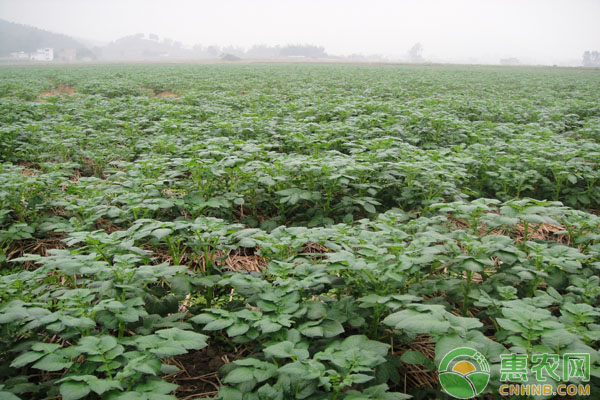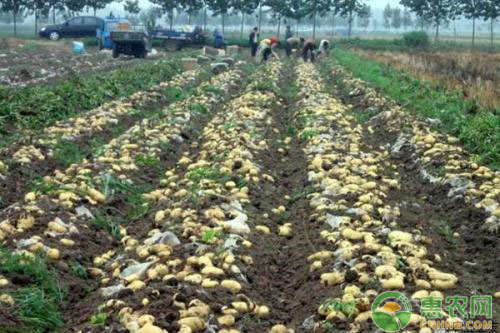When farmers grow potatoes, they always feel that they are not very good. Why? It may be that the step of detoxification is not done well. Then, let’s take a look at the potato detoxification technology with Xiaobian. First, why should you detoxify? 1. During the growth process of the potato, different viruses are infected by different natural environments, which destroys the normal function of the plant, resulting in the potato not growing normally, resulting in reduced yield and becoming a degraded strain. Caused great losses to production. 2. After the treatment of the shoot tip detoxification technology, the virus in the seed potato is cleaned out, so that it recovers from the pathological state to the healthy level, restores the characteristics of the original variety, and the physiological function reaches a vigorous state, and the metabolism can be carried out normally to ensure normal production. The smooth progress of the potato has greatly increased the yield of the potato and increased the income of the growers, so the virus is removed. Second, the principle of potato stem tip detoxification According to the heterogeneity of the distribution of the virus in the tissue of the potato plant, that is, the infection rate of the virus is slightly slower than the growth rate of the new tissue, so the parts close to the new tissue, such as the growth point of the apex and the stem tip, the growth cone of the new shoot At the same time, there is no actual situation in which there are few viruses or viruses. Under the special environment and equipment of aseptic, a small amount of shoot tip tissue is cut out on a special medium and cultured to grow into seedlings. Third, the source of virus-free seedlings 1. Field selection: The selected plants must exhibit typical characteristics of the cultivar, which are in line with the characteristics of the prepared detoxification cultivars, including agronomic traits such as plant type, leaf shape, flower color and other botanical traits and maturity; plant growth is robust , no obvious symptoms of viral, fungal, bacterial diseases; high yield per plant and high potato rate; early harvest early. After the harvest, the potato pieces are carefully selected to meet the characteristics of the potato pieces, including skin color, flesh color, potato shape, bud eye, etc., and the large potato without disease spots, insects and mechanical wounds is used as a detoxifying material. 2, disinfection of the surface of the detoxification material: first pass the bud in 75% of the alcohol (a few seconds), then use the saturated bleaching supernatant or diluted with sodium hypochlorite solution to 5% - 7%, soak for 15-20 minutes, Then wash with sterile water for 3-4 times. The sterilized material is placed in a sealed sterile bottle. 3. Pick up the shoot tip tissue: Take the treated stem tip and fix it with sterile forceps, and separate the meristem tissue at 30-40 times. Carefully remove the leaf tissue around the tip of the stem with a scalpel, expose the sleek growth point of the tip, and carefully cut the desired shoot tip meristem with a dissecting needle. Generally, the length of the stem tip is 0.1-0.3 mm, with 1-2 leaf primordia. 4. The peeled shoot tips are placed in the culture medium of the potato shoot tip meristem culture. Fourth, the production of virus-free seedlings 1. Washing all kinds of glassware: The washed utensils should be transparent and bright, and the inner and outer water films are uniform and do not hang water drops. The washed utensils should be placed on a water control rack to drain and dry. 2, inoculation room management matters needing attention: the inoculation room should be dry, dry, clean and bright. Thoroughly clean before inoculation and disinfect with 75% alcohol. The vaccinator has a buffer room at the entrance, washes his hands with soap, disinfects with 75% alcohol, and then passes the wind chimes to prevent dust from coming in. Change clothes and change shoes before entering the inoculation room. The buffer room should be air sterilized by ultraviolet light for half an hour. 3. Precautions for inoculation operation: Before starting work, the ultra-clean workbench should be turned on 20-30 minutes in advance. Scrub the workbench and clean your hands with 75% alcohol before inoculation. Inoculate utensils, scissors, tweezers, colonization needles, etc., immersed in 75% alcohol, and then sterilized by inserting into a sterilizer. After 3 to 5 minutes, take it out and put it on the stand to cool it before use to avoid burning the inoculated seedlings. Usually, each vaccinator is equipped with two sets of utensils, which are used alternately for sterilization. After the preparation is completed, the inoculation is formally completed. (1): The prepared seedlings are opened, and the plants are cut into about 1.5 cm stem segments with scissors, and placed in the medium (2): then the stems are clamped with tweezers. Insert the medium into the top of the section, (3) Burn the sealing paper with an alcohol lamp, seal, tighten the bottle mouth with a rope, (4) Then put the inoculated seedlings into the tissue culture room for cultivation, seedling age It is 25-30 days. 4, the environmental conditions required for the growth of virus-free seedlings: light is a very important environmental factor in tissue culture, light intensity and light time have a great impact on cell proliferation and organ differentiation, potato virus-free seedlings long sunshine And glare, under the conditions of artificial light filling in the culture room, according to local conditions, with a light time of 10 hours per day, a certain temperature difference between day and night is conducive to the robust growth of the virus-free seedlings. The optimal temperature for potato virus-free seedlings is 18-22 °C, and 16-20 °C at night. The humidity of the culture chamber is preferably 45 to 60%. When the humidity of the culture chamber is too low, the difference between the inside and the outside of the culture bottle is large, which will cause the water in the medium to lose quickly, which is not conducive to the growth and development of the virus-free seedling; if the humidity in the culture room is too high, it will cause the true bacteria in the indoor air. Spores rapidly multiply and are prone to mold contamination. V. Tissue culture seedling infection and prevention 1. Bacterial contamination mainly manifests in the presence of mucus or turbid water-stained marks or foamy fermentation in the vicinity of the culture material, or turbidity and cloud-like marks appear in the medium near the material. Bacterial pollution characteristics: the plaque is mucus, time: generally inoculated for 1-2 days, the reason can be found: in addition to the plant material carrier or the medium is not completely sterilized, the operator's improper operation is also causing bacterial contamination. main reason. It is mainly caused by the use of unsterilized tools and bacteria exhaled during breathing; it may also be the touch of materials or utensil edges, causing bacteria to fall into materials or utensils, causing pollution. 2, fungal contamination symptoms: fungal contamination is the mold on the medium, mildew, black, white, yellow and other colors. Appearance time: usually occurs after 3 days of vaccination, and the time is up to 10 days. Cause: Fungal contamination is generally caused by unclean surroundings and air pollution. For example, the air in the inoculation room itself is unclean and dusty; the filtering device of the ultra-clean workbench fails; the diameter of the culture vessel is too large, and the staff is inadvertently operated. During the operation, the fungus spores at the edge of the bottle mouth are dropped into the bottle due to opening the stopper, or the fungal spores which are raised when the sealing paper is removed and the rope of the sealing paper is removed, resulting in air pollution in the inoculation chamber. 3, strict procedures, standardized operations: reasonable control of environmental conditions, strict procedures, scientific and standardized operations. The production of virus-free seedlings is the source of potato production. Detoxification is essential, so it must be strictly controlled in the operation direction, so that good detoxification seedlings can be produced, laying a good foundation for future production, increasing production and ensuring quality.
IV Infusion:
Intravenous simply
means "within vein" (or "inside the vein"). Therapies
administered intravenously are often included in the designation of specialty
drugs. Intravenous infusions are commonly referred to as drips because many
systems of administration employ a drip chamber, which prevents air from entering
the blood stream (air embolism), and allows an estimation of flow rate.
Intravenous
therapy may be used to correct electrolyte imbalances, to deliver medications,
for blood transfusion or as fluid replacement to correct, for example,
dehydration. Intravenous therapy can also be used for chemotherapy.
Compared with
other routes of administration, the intravenous route is the fastest way to
deliver fluids and medications throughout the body. The bioavailability of the
medication is 100% in IV therapy.
Intravenous
infusions are fluid solutions administered through a vein. There are numerous
different types of solutions available, but they can be broken down into simple
categories depending on the function they serve. Some replace lost fluids, and
others provide nutrients, replace lost blood, and deliver medications.
One of the most
common uses for intravenous infusions is to replenish fluids lost through
dehydration. These infusions often contain normal saline solution, a
combination of sterile water and sodium chloride. This solution is known as an
isotonic crystalloid, or a solution that contains the same amount of
electrolytes as plasma in the body. It is used in cases of moderate to severe
dehydration, such as that caused by vomiting or diarrhea, when replacing the
fluids quickly is vital.
When a patient`s
gastrointestinal tract is compromised and nutrients cannot be absorbed - or
eating can worsen the condition - intravenous infusions called total parenteral
nutrition may be given. These solutions contain a mix of sterile water,
electrolytes, sugar, proteins, fats, and other nutrients, depending on the
needs of the patient. Diseases and disorders that commonly require total
parenteral nutrition include late stages of Crohn`s disease, obstructive bowel
disorder, and ulcerative colitis.
Intravenous
infusions are also used to deliver medication directly to the blood stream.
Certain medications, such as intravenous immunoglobulin, a type of antibody,
can only be given through the vein. Other medications, such as certain narcotic
pain relievers, are given intravenously because the method allows them to they
work faster than when taken orally. Chemotherapy for treatment of cancer is
also typically given intravenously.
When performed by
a medical professional, intravenous infusions are typically safe. The most
common reaction is mild pain and redness at the site of the injection, although
different medications may cause different side effects. Any time the skin is
punctured, there is a risk of infection. Having a medical professional,
typically a nurse, monitor the intravenous infusion and change the injection
site when irritation is evident can help prevent complications.
IV Infusion,Glucose IV Infusion,Intravenous Infusion NOUVASANT GROUP LTD. , https://www.nouvasant.com
